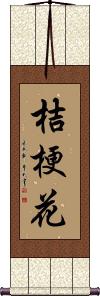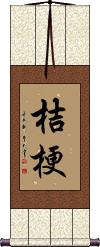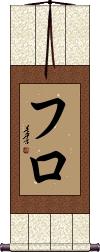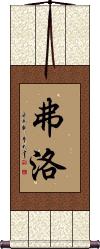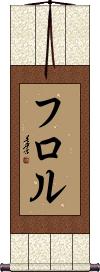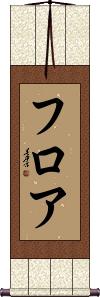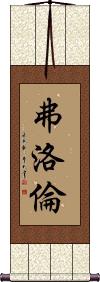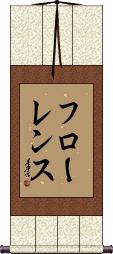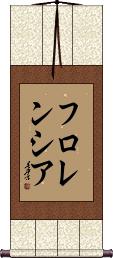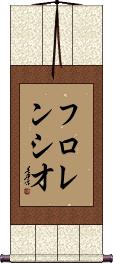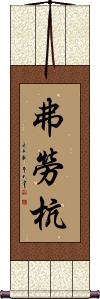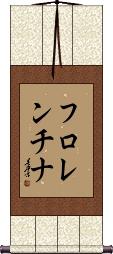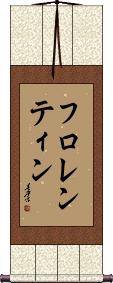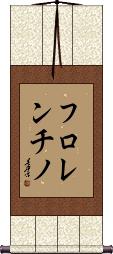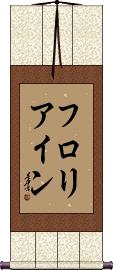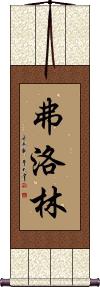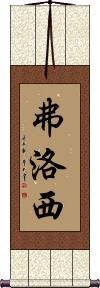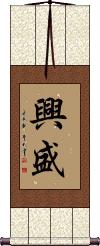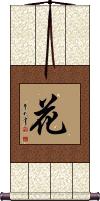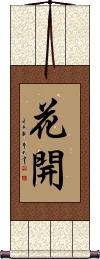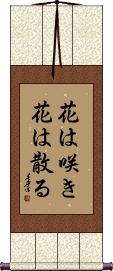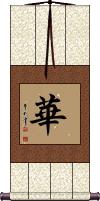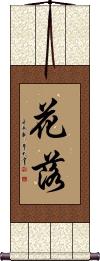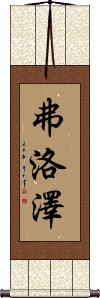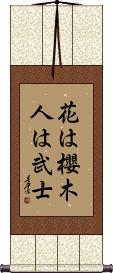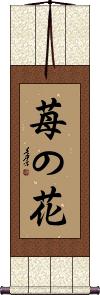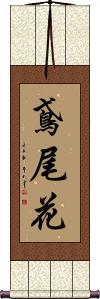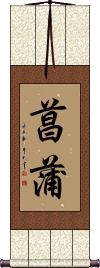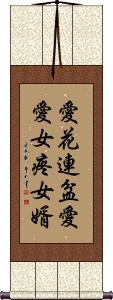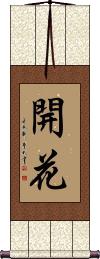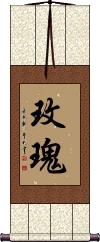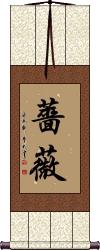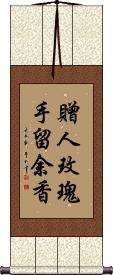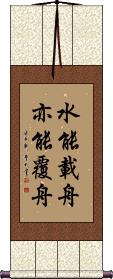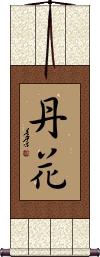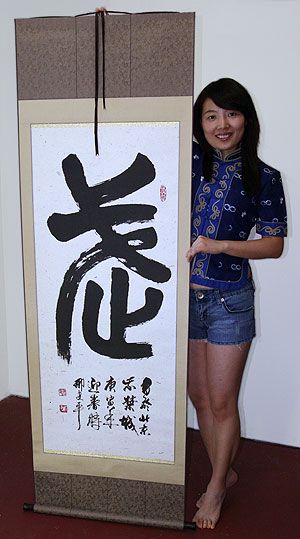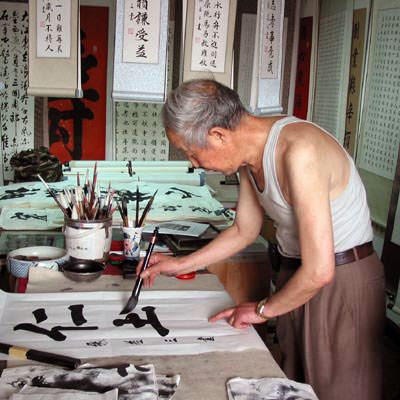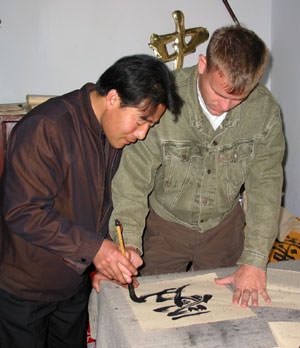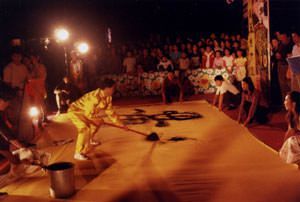The Name Flo in Japanese/Chinese on a Custom-Made Wall Scroll.
Click the "Customize" button next to your name below to start your personalized flo calligraphy artwork...
Switched to secondary search mode due to lack of results using primary.
These secondary results may not be very accurate. Try a different but similar meaning word or phrase for better results. Or...
Look up Flo in my Japanese Kanji & Chinese Character Dictionary(My dictionary is a different system then the calligraphy search you just tried)
If you want a special phrase, word, title, name, or proverb, feel free to contact me, and I will translate your custom calligraphy idea for you.
1. Bellflower
2. Bellflower / Herb of Bellflower
3. Flo
4. Flor
5. Flora
6. Flore
7. Floren
8. Florena
9. Florence
10. Florencia
11. Florencio
12. Florent
13. Florentina
14. Florentine
15. Florentino
16. Flores
17. Floria
18. Florian
19. Floriane
20. Florida
21. Florin
22. Florine
23. Floris
24. Flors
25. Flossie
26. Flourish
27. Flourish and Blossom Everywhere
28. Flower
29. Flower Open / Blooming Flower
30. Flowers Bloom and Flowers Fall
31. Flowers Bloom and Flowers Wither
32. Flowers / Blooming / Splendid / China
33. Flowers Fall / The End Comes
34. Flower in the Mirror, Moon on Water
35. Flowers
36. Floyd
37. Flozer
38. Go With The Flow
39. In Flowers the Cherry Blossom, In Men the Samurai
40. Holding Flowers with Subtle Smile
41. Ichigo No Hana / Strawberry Flower
42. Iris Flower
43. Jasmine Flower
44. Love the Flower, Love the Pot also
45. Magnolia Flower
47. Opening / Blooming Flowers
48. Rose Flower
49. Rose Flowers Given, Frangrance Remains on Hands of Giver
50. Not Only Can Water Float A Boat, It Can Sink It Also
51. Red Flower
Bellflower
桔梗花 means “Chinese bellflower” in Japanese.

桔梗花 is the three-character version of this title, which suggests that you are talking about the flower and not the medicinal herb derived from this kind of plant.
Bellflower / Herb of Bellflower
桔梗 means “Chinese bellflower” in Japanese.
In Chinese, it refers to the “Platycodon grandiflorus” (Platycodon grandiflorum), “balloon flower,” or “bellflower.”
Please note that in Chinese, this particular 2-character title suggests that you are talking about the medicinal herb derived from the stem of this flower/plant.
Flor
Flor
Flora
Flora
Flore
Flore
Floren
Floren
Florena
Florena
Florence
Florence
Florence
Florencia
Florencia
Florencio
Florencio
Florent
Florent
Florentina
Florentina
Florentine
Florentine
Florentino
Florentino
Flores
Flores
Floria
Floria
Florian
Florian
Floriane
Floriane
Florida
Florida
Florin
Florin
Florine
Florine
Floris
Floris
Flors
Flors
Flossie
Flossie
Flourish
Flourish and Blossom Everywhere
Flower
花 is the simple way to write “flower” in Chinese, Japanese, and old Korean.
It can also mean blossoms or can refer to a fancy or assorted pattern.
Note: In some contexts, it can mean “spend money.” However, as a single character, it will be read as a flower.
This has the meaning of Xochitl (flower) in Spanish, so if your name is Xochitl, I suggest this character to represent your name.
More random information about this character:
花 is the Korean surname spelled as “Hwa” before the Korean Romanization reformation of 2000-2001.
It's also a somewhat common given name in China (for females).
花 is a borrowed word from Chinese, so it sounds similar in Chinese and Korean.
Flower Open / Blooming Flower
These two characters mean “flower open.”
花開 is also associated with Springtime, the beginning of something, or youth.
花開 is often followed by 花落 or “flower falls” (closes and loses its petals) which means “Things come and go” or “Youth comes and goes.”
If you like flowers and Springtime, this is a great selection for you. However, if you want the companion “flower falls” (flower withers), we offer that as a companion wall scroll or all together as a four-character phrase.
See Also: Flowers Fall
Flowers Bloom and Flowers Fall
花開花落 is a complete proverb that lightly speaks of the cycle of life, or how things come and go in life.
This is used as a metaphor to suggest that youth is a temporary state that in time will pass.
This can also be used to suggest that fortunes can come and go (everything is temporary).
Note: There are two very similar versions of this proverb. The other uses a word that means wither instead of fall.
Flowers Bloom and Flowers Fall
花は咲き花は散る is a Japanese proverb about the cycle of life, or how things come and go in life.
This can be used to suggest that youth, fortune, and life can come and go (everything is temporary).
Note: Because this selection contains some special Japanese Hiragana characters, it should be written by a Japanese calligrapher.
Flowers Bloom and Flowers Wither
花開花謝 is a complete proverb that lightly speaks of the cycle of life, or how things come and go in life.
This is used as a metaphor to suggest that youth is a temporary state, which in time, will pass.
This proverb can be used to suggest that fortunes can come and go (everything is temporary).
Note: There are two very similar versions of this proverb. The other uses a word that means fall instead of wither.
Flowers / Blooming / Splendid / China
華 means blooming flowers or splendid China.
華 is really open to interpretation. 華 meant flowers or blooming in ancient China. It still has that meaning in Japanese, and Buddhist contexts.
In modern China, this means glorious, beautiful, splendid, magnificent, or the best part of something. It can also refer to the country of China or something Chinese (such as people - overseas Chinese are often called “hua ren”). 華 is also a surname in China.
In Japanese, this can be the female given name “Ririka.” It's also the short name for a certain kind of playing cards in Japan.
In Korean, This can be the surname “Hwa.” While it also means splendid, flowery, or the country of China in Korean.
Flowers Fall / The End Comes
花落 means flower fall (closes and loses its petals).
It suggests nearing the end of something. A time that some might call “The sunset of life.” 花落 often follows 花開 or “flower open” to talk of the cycle of life.
We offer this as a possible companion to a “flower open” scroll (to be placed side by side or at either side of a doorway to say “things come and go” - a cool metaphor for a doorway). If placed in a doorway, it could be used to suggest to your guests that things bloom when they arrive through your door but wither when they leave (a great compliment).
See Also: Flowers Bloom
Flower in the Mirror, Moon on Water
鏡花水月 is an old Asian proverb that means “flowers in a mirror and the moon reflected in the lake” or “flowers reflected on a mirror and the moon reflected on the water's surface.”
Literally, 鏡花水月 reads “Mirror Flower, Water Moon.”
Figuratively this can be used to represent a lot of different ideas. It can be used to express an unrealistic rosy view or viewing things through rose-tinted spectacles. So you can use it to relay an idea about something that is visible but has no substance,
something that can be seen but not touched, or something beautiful but unattainable such as dreams or a mirage.
This expression is used to describe things like the subtle and profound beauty of poems that cannot be described in words.
鏡 = Mirror (or lens)
花 = Flower(s)
水 = Water
月 = Moon
Can also be written 水月鏡花 (just a slight change in word/character order).
Flowers
(family name)
弗勞爾斯 is the transliteration to Mandarin Chinese for the family name Flowers.
This sounds like "Flowers" in Mandarin Chinese but does not mean flowers in any way, shape or form. I strongly suggest the single character which means "flower" in Chinese, Japanese Kanji, and old Korean Hanja.
See Also: Flower
Floyd
Floyd
Flozer
Flozer
Go With The Flow
Go With The Flow
In Flowers the Cherry Blossom, In Men the Samurai
This Japanese proverb simply reads, “[In] Flowers it's Cherry Blossoms, [In] Men it's Warriors.”
花は櫻木人は武士 is meant to say that of all the flowers in the world, the cherry blossom is the best. And of all men in the world, the Samurai or Warrior is the best
This proverb has been around for a long time. It's believed to have been composed sometime before the Edo Period in Japan (which started in 1603).
Some will drop one syllable and pronounce this, “hana wa sakura hito wa bushi.” That's “sakura” instead of “sakuragi,” which is like saying “cherry blossom” instead of “cherry tree.”
The third character was traditionally written as 櫻. But in modern Japan, that became 桜. You may still see 櫻 used from time to time on older pieces of calligraphy. We can do either one, so just make a special request if you want 櫻.
Note: Because this selection contains some special Japanese Hiragana characters, it should be written by a Japanese calligrapher.
Holding Flowers with Subtle Smile
An idiom for heart-to-heart communication
拈華微笑 is a Chinese, Korean, and Japanese Buddhist title that relays the idea of “heart-to-heart communication,” or “thought transference.”
The literal translation is, “holding a flower and subtly smiling,” or “the holding of a flower with a subtle smile.” It is the visual act and emotion that communicates more volume than words can say.
Ichigo No Hana / Strawberry Flower
Iris Flower
鳶尾花 is the title for the iris flower in Chinese and Japanese.
If your name happens to be Iris, this is a beautiful way to express your name by meaning in both of these languages (it will mean your name but not sound like your name).
Can also mean wall iris, roof iris, or Iris tectorum.
Note: There are other titles for specific iris varieties - contact us if you need something special.
Iris Flower
菖蒲 is the title for the iris flower in Japanese.
If your name happens to be Iris, this is a nice way to express your name by meaning in Japanese (it will mean your name but not sound like your name).
Can also mean Siberian iris (Iris sanguinea) or sweet flag (Acorus calamus / Acorus gramineus) varieties.
Note: This will also be recognized in Chinese, though it is generally written with the addition of a character meaning "stone" in front of this title in Chinese.
Jasmine Flower
Love the Flower, Love the Pot also
Love Me, Love My Dog
This proverb, 爱花连盆爱爱女疼女婿, literally translates as “If one loves a flower, [one will] love its pot; [if one really] loves [one's] daughter, [one will also] love [one's] son-in-law.”
Figuratively, is similar to the English proverbs:
Love me, love my dog.
Love for a person extends even to the crows on his roof.
Magnolia Flower
No Rain No Flowers
Opening / Blooming Flowers
開花 literally means opening flowers (a verb).
開花 is also associated with Springtime, the beginning of something, or youth.
If you like flowers and Springtime, this is a great selection for you.
In Korean Hanja, this can be a metaphor for achieving enlightenment or becoming civilized (blooming civilization).
See Also: Flowers Fall
Rose Flower
(The flower of love)
Rose Flower
(The flower of love)
薔薇 is the universal way to write rose (as in the flower) because it is understood in both Chinese and Japanese (same characters in either language). 薔薇 is also a common way to write about roses in Asian poetry. This can be translated as “wild rose” if you are looking for that title.
薔薇 is also how to write “rose” in old Korean Hanja (though they now use Hangul, and most Koreans of this generation will not be able to read this without a dictionary).
Rose Flowers Given, Frangrance Remains on Hands of Giver
赠人玫瑰手留余香 is a proverb that has been translated several ways:
1. Roses given, fragrance in hand.
2. You present others roses, and the fragrance remains.
3. The fragrance of the rose always remains on the hand of those that bestow them.
4. A little bit of fragrance always clings to the hands which gives the flowers
However, this literally translates as “Give someone rose flowers, [your] hands keep [the] remaining fragrance.”
Not Only Can Water Float A Boat, It Can Sink It Also
Many things have opposite properties. The water you drink can also drown you. Pork may nourish you and keep you alive but under-cook it and it could kill you. Potassium nitrate is often used as a fertilizer to grow the food that sustains us but it's also been used as an explosive to topple buildings and destroy us.
This concept is easily associated with “yin yang” where an element has two opposite properties that are as different as night and day.
This proverb's meaning can be summed up this way: “Anything that can lead you to success may also contain great risks.”
This phrase is known in literary circles by Korean people (scholars or literature). It is therefore also a valid proverb in Korean Hanja, though most Koreans would not be able to make sense of it.
Please note that there is an unwritten rule when the same character appears twice in the same phrase, the calligrapher will alter the appearance so that no two characters are exactly alike in the same piece. This calligraphy has two repeating characters that will be written differently than they appear here.
Red Flower
The following table may be helpful for those studying Chinese or Japanese...
| Title | Characters | Romaji (Romanized Japanese) | Various forms of Romanized Chinese | |
| Bellflower | 桔梗花 | ki kyou bana kikyoubana ki kyo bana | jié gěng huā jie2 geng3 hua1 jie geng hua jiegenghua | chieh keng hua chiehkenghua |
| Bellflower Herb of Bellflower | 桔梗 | ki kyou / kikyou / ki kyo | jié gěng / jie2 geng3 / jie geng / jiegeng | chieh keng / chiehkeng |
| Flo | フロ | furo | ||
| Flo | 弗洛 | fú luò / fu2 luo4 / fu luo / fuluo | fu lo / fulo | |
| Flor | 弗落爾 弗落尔 | fú luò ěr fu2 luo4 er3 fu luo er fuluoer | fu lo erh fuloerh |
|
| Flor | フロル | furoru | ||
| Flora | 弗羅拉 弗罗拉 | fú luó lā fu2 luo2 la1 fu luo la fuluola | fu lo la fulola |
|
| Flora | フローラ | furoora / furora | ||
| Flore | 弗落爾 弗落尔 | fú luò ěr fu2 luo4 er3 fu luo er fuluoer | fu lo erh fuloerh |
|
| Flore | フロア | furoa | ||
| Floren | 弗洛倫 弗洛伦 | fú luò lún fu2 luo4 lun2 fu luo lun fuluolun | fu lo lun fulolun |
|
| Floren | フローレン | furooren / furoren | ||
| Florena | 弗洛雷納 弗洛雷纳 | fú luò léi nà fu2 luo4 lei2 na4 fu luo lei na fuluoleina | fu lo lei na fuloleina |
|
| Florena | フロレナ | furorena | ||
| Florence | 佛羅倫薩 佛罗伦萨 | fó luó lún sà fo2 luo2 lun2 sa4 fo luo lun sa foluolunsa | fo lo lun sa fololunsa |
|
| Florence | 弗羅倫絲 弗罗伦丝 | fú luó lún sī fu2 luo2 lun2 si1 fu luo lun si fuluolunsi | fu lo lun ssu fulolunssu |
|
| Florence | フローレンス | furoorensu / furorensu | ||
| Florencia | 弗洛倫西亞 弗洛伦西亚 | fú luò lún xī yà fu2 luo4 lun2 xi1 ya4 fu luo lun xi ya fuluolunxiya | fu lo lun hsi ya fulolunhsiya |
|
| Florencia | フロレンシア | furorenshia | ||
| Florencio | 弗洛倫西奧 弗洛伦西奥 | fú luò lún xī ào fu2 luo4 lun2 xi1 ao4 fu luo lun xi ao fuluolunxiao | fu lo lun hsi ao fulolunhsiao |
|
| Florencio | フロレンシオ | furorenshio | ||
| Florent | 弗勞杭 弗劳杭 | fú láo háng fu2 lao2 hang2 fu lao hang fulaohang | ||
| Florent | フロラン | furoran | ||
| Florentina | 弗洛倫蒂娜 弗洛伦蒂娜 | fú 了uò luò dì nà fu2 luo4 di4 na4 fu luo di na fuluodina | fu lo ti na fulotina |
|
| Florentina | フロレンチナ | furorentina | ||
| Florentine | 弗勞杭汀 弗劳杭汀 | fú láo háng tīng fu2 lao2 hang2 ting1 fu lao hang ting fulaohangting | fu lao hang t`ing fulaohangting fu lao hang ting |
|
| Florentine | フロレンティン | furorentin | ||
| Florentino | 弗洛倫蒂諾 弗洛伦蒂诺 | fú luò lún dì nuò fu2 luo4 lun2 di4 nuo4 fu luo lun di nuo fuluolundinuo | fu lo lun ti no fuloluntino |
|
| Florentino | フロレンチノ | furorentino | ||
| Flores | 弗羅來絲 弗罗来丝 | fú luó lái sī fu2 luo2 lai2 si1 fu luo lai si fuluolaisi | fu lo lai ssu fulolaissu |
|
| Flores | フロラス | furorasu | ||
| Floria | 弗洛里亞 弗洛里亚 | fú luò lǐ yà fu2 luo4 li3 ya4 fu luo li ya fuluoliya | fu lo li ya fuloliya |
|
| Floria | フロリア | furoria | ||
| Florian | 弗洛里安 | fú luò lǐ ān fu2 luo4 li3 an1 fu luo li an fuluolian | fu lo li an fulolian |
|
| Florian | フロリアン | furorian | ||
| Floriane | 弗洛莉安 | fú luò lì ān fu2 luo4 li4 an1 fu luo li an fuluolian | fu lo li an fulolian |
|
| Floriane | フロリアイン | furoriain | ||
| Florida | 佛羅里達 佛罗里达 | fó luó lǐ dá fo2 luo2 li3 da2 fo luo li da foluolida | fo lo li ta fololita |
|
| Florida | フロリダ | furorida | ||
| Florin | 弗洛林 | fú luò lín fu2 luo4 lin2 fu luo lin fuluolin | fu lo lin fulolin |
|
| Florin | フローリン | furoorin / furorin | ||
| Florine | 芙羅琳 芙罗琳 | fú luó lín fu2 luo2 lin2 fu luo lin fuluolin | fu lo lin fulolin |
|
| Florine | フロリン | furorin | ||
| Floris | 弗洛里斯 | fú luò lǐ sī fu2 luo4 li3 si1 fu luo li si fuluolisi | fu lo li ssu fulolissu |
|
| Floris | フロリス | furorisu | ||
| Flors | 弗洛爾斯 弗洛尔斯 | fú luò ěr sī fu2 luo4 er3 si1 fu luo er si fuluoersi | fu lo erh ssu fuloerhssu |
|
| Flors | フロース | furoosu / furosu | ||
| Flossie | 弗洛西 | fú luò xī fu2 luo4 xi1 fu luo xi fuluoxi | fu lo hsi fulohsi |
|
| Flossie | フロッシー | furosshii / furoshi | ||
| Flourish | 興盛 兴盛 | kou sei / kousei / ko sei | xīng shèng xing1 sheng4 xing sheng xingsheng | hsing sheng hsingsheng |
| Flourish and Blossom Everywhere | 遍地開花 遍地开花 | biàn dì kāi huā bian4 di4 kai1 hua1 bian di kai hua biandikaihua | pien ti k`ai hua pientikaihua pien ti kai hua |
|
| Flower | 花 | hana | huā / hua1 / hua | |
| Flower Open Blooming Flower | 花開 花开 | huā kāi / hua1 kai1 / hua kai / huakai | hua k`ai / huakai / hua kai | |
| Flowers Bloom and Flowers Fall | 花開花落 花开花落 | huā kāi huā luò hua1 kai1 hua1 luo4 hua kai hua luo huakaihualuo | hua k`ai hua lo huakaihualo hua kai hua lo |
|
| Flowers Bloom and Flowers Fall | 花は咲き花は散る | hana wa sa ki hana wa chi ru hanawasakihanawachiru | ||
| Flowers Bloom and Flowers Wither | 花開花謝 花开花谢 | huā kāi huā xiè hua1 kai1 hua1 xie4 hua kai hua xie huakaihuaxie | hua k`ai hua hsieh huakaihuahsieh hua kai hua hsieh |
|
| Flowers Blooming Splendid China | 華 华 | ririka | huá / hua2 / hua | |
| Flowers Fall The End Comes | 花落 | huā sà / hua1 luo4 / hua luo / hualuo | hua lo / hualo | |
| Flower in the Mirror, Moon on Water | 鏡花水月 镜花水月 | kyou ka sui getsu kyoukasuigetsu kyo ka sui getsu | jìng huā shuǐ yuè jing4 hua1 shui3 yue4 jing hua shui yue jinghuashuiyue | ching hua shui yüeh chinghuashuiyüeh |
| Flowers | 弗勞爾斯 弗劳尔斯 | fú láo ěr sī fu2 lao2 er3 si1 fu lao er si fulaoersi | fu lao erh ssu fulaoerhssu |
|
| Floyd | 弗洛伊德 | fú luò yī dé fu2 luo4 yi1 de2 fu luo yi de fuluoyide | fu lo i te fuloite |
|
| Floyd | フロイド | furoido | ||
| Flozer | 弗洛澤 弗洛泽 | fú luò zé fu2 luo4 ze2 fu luo ze fuluoze | fu lo tse fulotse |
|
| Flozer | フロザー | furozaa / furoza | ||
| Go With The Flow | 隨波逐流 随波逐流 | suí bō zhú liú sui2 bo1 zhu2 liu2 sui bo zhu liu suibozhuliu | sui po chu liu suipochuliu |
|
| Go With The Flow | 波に乗る | namininoru | ||
| In Flowers the Cherry Blossom, In Men the Samurai | 花は櫻木人は武士 花は桜木人は武士 | hana wa sakuragi hito wa bushi | ||
| Holding Flowers with Subtle Smile | 拈華微笑 拈华微笑 | nenge misho nengemisho | niān huá wēi xiào nian1 hua2 wei1 xiao4 nian hua wei xiao nianhuaweixiao | nien hua wei hsiao nienhuaweihsiao |
| Ichigo No Hana Strawberry Flower | 苺の花 | ichigo no hana ichigonohana | ||
| Iris Flower | 鳶尾花 鸢尾花 | ichi hatsu hana ichihatsuhana | yuān wěi huā yuan1 wei3 hua1 yuan wei hua yuanweihua | yüan wei hua yüanweihua |
| Iris Flower | 菖蒲 | ayame / shoubu ayame / shobu | chāng pú / chang1 pu2 / chang pu / changpu | ch`ang p`u / changpu / chang pu |
| Jasmine Flower | 茉莉花 | ma ri ka / marika | mò lì huā mo4 li4 hua1 mo li hua molihua | |
| Love the Flower, Love the Pot also | 愛花連盆愛愛女疼女婿 爱花连盆爱爱女疼女婿 | ài huā lián pén ài ài nǚ téng nǚ xù ai4 hua1 lian2 pen2 ai4 ai4 nv3 teng2 nv3 xu4 ai hua lian pen ai ai nv teng nv xu | ai hua lien p`en ai ai nü t`eng nü hsü ai hua lien pen ai ai nü teng nü hsü |
|
| Magnolia Flower | 木蘭花 木兰花 | mù lán huā mu4 lan2 hua1 mu lan hua mulanhua | ||
| No Rain No Flowers | 無雨無花 无雨无花 | wú yù wú huā wu2 yu4 wu2 hua1 wu yu wu hua wuyuwuhua | wu yü wu hua wuyüwuhua |
|
| Opening Blooming Flowers | 開花 开花 | kai ka / kaika | kāi huā / kai1 hua1 / kai hua / kaihua | k`ai hua / kaihua / kai hua |
| Rose Flower | 玫瑰 | méi guì / mei2 gui4 / mei gui / meigui | mei kuei / meikuei | |
| Rose Flower | 薔薇 蔷薇 | bara / shoubi bara / shobi | qiáng wēi qiang2 wei1 qiang wei qiangwei | ch`iang wei chiangwei chiang wei |
| Rose Flowers Given, Frangrance Remains on Hands of Giver | 贈人玫瑰手留余香 赠人玫瑰手留余香 | zèng rén méi guī shǒu liú yú xiāng zeng4 ren2 mei2 gui1 shou3 liu2 yu2 xiang1 zeng ren mei gui shou liu yu xiang | tseng jen mei kuei shou liu yü hsiang | |
| Not Only Can Water Float A Boat, It Can Sink It Also | 水能載舟亦能覆舟 水能载舟亦能覆舟 | shuǐ néng zài zhōu yì néng fù zhōu shui3 neng2 zai4 zhou1 yi4 neng2 fu4 zhou1 shui neng zai zhou yi neng fu zhou | shui neng tsai chou i neng fu chou | |
| Red Flower | 丹花 | tan ga / tanga | ||
| In some entries above you will see that characters have different versions above and below a line. In these cases, the characters above the line are Traditional Chinese, while the ones below are Simplified Chinese. | ||||
